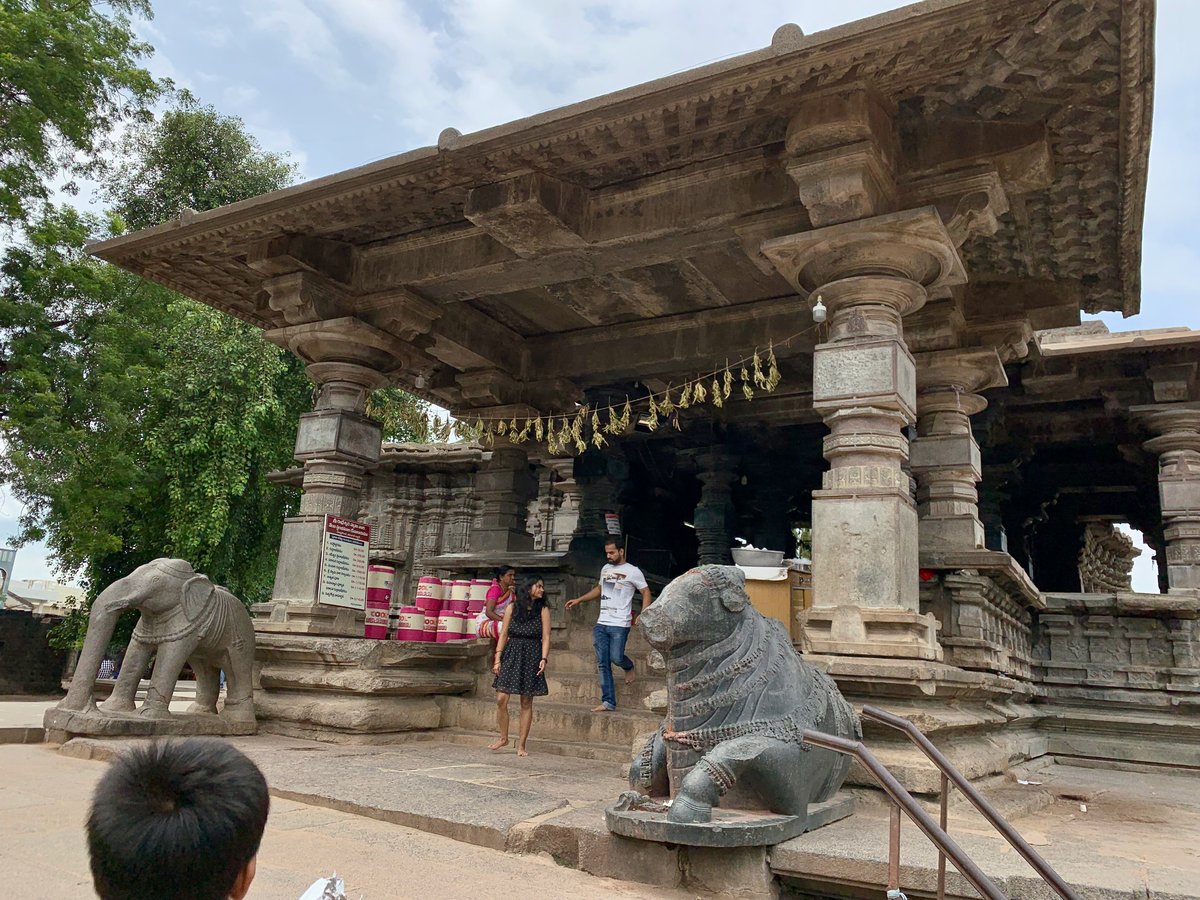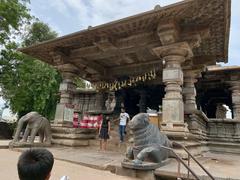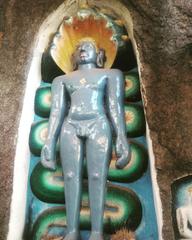
Comprehensive Guide to Visiting Kakatiyula Veyi Stambhala Devalayam, Kazipet, India
Publication Date: 17/07/2024
Introduction to Kakatiyula Veyi Stambhala Devalayam
The Kakatiyula Veyi Stambhala Devalayam, commonly known as the Thousand Pillar Temple, stands as a testament to the architectural brilliance and cultural richness of the Kakatiya dynasty. Located in Kazipet, India, this historic Hindu temple dates back to the 12th century and showcases the advanced engineering skills and artistic sensibilities of its time. Commissioned by King Rudra Deva in 1163 AD, the temple is dedicated to three deities—Shiva, Vishnu, and Surya—reflecting the syncretic nature of Kakatiya religious practices (Archaeological Survey of India).
The temple is renowned for its intricate carvings and star-shaped architecture, supported by a thousand uniquely carved pillars. It also features a majestic Nandi mandapa, which houses a massive monolithic statue of Nandi, the sacred bull of Lord Shiva. Over the centuries, the temple has withstood invasions and natural calamities, yet it remains a significant religious and cultural site. Restoration efforts by the Archaeological Survey of India have helped preserve its architectural integrity (Telangana Tourism).
This guide aims to provide visitors with essential information on the temple’s history, visiting hours, ticket details, travel tips, and nearby attractions. Whether you are a history enthusiast, an architectural aficionado, or a spiritual seeker, the Thousand Pillar Temple offers a unique and enriching experience that highlights India’s glorious past and enduring cultural heritage.
Contents Overview
- Introduction
- History of the Thousand Pillar Temple
- Visitor Information
- Nearby Attractions
- Historical Events and Restoration
- Cultural and Religious Importance
- Preservation and Modern-Day Relevance
- Frequently Asked Questions (FAQ)
- Conclusion
- Call to Action
- Cited Sources and Further Reading
History of the Thousand Pillar Temple
Origins and Construction
The Thousand Pillar Temple is a historic Hindu temple located in Kazipet, India. This architectural marvel was constructed during the reign of the Kakatiya dynasty, which ruled the region from the 12th to the 14th centuries. The temple was commissioned by King Rudra Deva in 1163 AD, a period marked by significant cultural and architectural advancements in the Deccan region.
The temple is dedicated to three deities—Shiva, Vishnu, and Surya—reflecting the syncretic nature of the Kakatiya dynasty’s religious practices. The construction of the temple is attributed to the Kakatiya rulers’ desire to showcase their devotion and architectural prowess. The temple’s design is a testament to the engineering skills and artistic sensibilities of the Kakatiya artisans.
Architectural Significance
The Thousand Pillar Temple is renowned for its intricate architecture and elaborate carvings. The temple complex is built in the shape of a star, a common feature in Kakatiya architecture, and is supported by a thousand pillars, each uniquely carved with detailed sculptures and motifs. The pillars are arranged in such a way that they create a labyrinthine effect, adding to the temple’s mystique and grandeur.
One of the most striking features of the temple is the Nandi mandapa, which houses a massive monolithic statue of Nandi, the sacred bull of Lord Shiva. The Nandi statue is intricately carved and is considered one of the finest examples of Kakatiya sculpture. The temple also features a large central hall, or maha mandapa, which is supported by intricately carved pillars and serves as the main area for worship and gatherings.
Visitor Information
Visiting Hours
The Thousand Pillar Temple is open to visitors from 6:00 AM to 8:00 PM every day. It is advisable to visit early in the morning or late in the evening to avoid the crowds and enjoy the serene atmosphere.
Tickets
Entry to the Thousand Pillar Temple is free of charge. However, there may be nominal fees for guided tours or special events, which can be paid at the entrance.
Travel Tips
- Best Time to Visit: The ideal time to visit the Thousand Pillar Temple is during the winter months (November to February) when the weather is pleasant.
- Footwear: Visitors are required to remove their footwear before entering the temple premises. It is recommended to carry a bag for your shoes.
- Photography: Photography is allowed inside the temple, but it is advisable to seek permission for professional equipment.
- Guided Tours: Consider hiring a guide to gain deeper insights into the temple’s history and architecture.
Nearby Attractions
Kazipet and the surrounding regions offer several other historical and cultural attractions:
- Warangal Fort: A short drive from the temple, the Warangal Fort is another architectural marvel from the Kakatiya dynasty.
- Bhadrakali Temple: Located in Warangal, this temple is one of the oldest in the region and is dedicated to Goddess Bhadrakali.
- Ramappa Temple: Known for its intricate carvings and beautiful architecture, this temple is a UNESCO World Heritage Site.
Historical Events and Restoration
Over the centuries, the Thousand Pillar Temple has witnessed numerous historical events, including invasions and natural calamities. The temple suffered significant damage during the invasions by the Delhi Sultanate in the 14th century, which led to the decline of the Kakatiya dynasty. Despite the damage, the temple remained an important religious and cultural site for the local population.
In the 20th century, efforts were made to restore the temple to its former glory. The Archaeological Survey of India (ASI) undertook extensive restoration work to preserve the temple’s architectural integrity and historical significance. The restoration process involved meticulous documentation and reconstruction of the damaged sections, ensuring that the temple’s original design and craftsmanship were preserved.
Cultural and Religious Importance
The Thousand Pillar Temple holds immense cultural and religious significance for the people of Kazipet and the surrounding regions. The temple is a major pilgrimage site, attracting devotees from across India who come to seek blessings and participate in religious ceremonies. The temple’s annual festivals, such as Maha Shivaratri and Kakatiya Festival, draw large crowds and are celebrated with great fervor and enthusiasm.
The temple also serves as a center for cultural activities and traditional arts. The intricate carvings and sculptures on the temple walls depict scenes from Hindu mythology, historical events, and everyday life, providing valuable insights into the cultural and social life of the Kakatiya period. The temple’s architecture and art continue to inspire contemporary artists and architects, making it a living testament to the region’s rich cultural heritage.
Preservation and Modern-Day Relevance
In recent years, the Thousand Pillar Temple has gained recognition as a significant heritage site, both nationally and internationally. The temple is included in the tentative list of UNESCO World Heritage Sites, highlighting its global importance and the need for its preservation. The ASI, along with local authorities and heritage organizations, continues to work towards the conservation and promotion of the temple.
Modern technology and digital documentation have played a crucial role in the preservation efforts. Detailed 3D scans and digital models of the temple have been created to aid in restoration and to provide virtual access to the site for researchers and enthusiasts worldwide. These efforts ensure that the temple’s historical and cultural legacy is preserved for future generations.
The Thousand Pillar Temple remains a symbol of the Kakatiya dynasty’s architectural and cultural achievements. Its rich history, intricate architecture, and enduring cultural significance make it a must-visit destination for anyone interested in India’s heritage. The temple stands as a testament to the region’s glorious past and continues to inspire awe and reverence among visitors and devotees alike.
Frequently Asked Questions (FAQ)
Q: What are the visiting hours of the Thousand Pillar Temple?
A: The temple is open from 6:00 AM to 8:00 PM every day.
Q: How much are the tickets to the Thousand Pillar Temple?
A: Entry to the temple is free, but there may be fees for guided tours or special events.
Q: Are there any special events at the Thousand Pillar Temple?
A: Yes, the temple hosts annual festivals like Maha Shivaratri and the Kakatiya Festival.
Conclusion
The Thousand Pillar Temple is not just a monument but a vibrant symbol of India’s rich past. Whether you are a history enthusiast, an architectural aficionado, or a spiritual seeker, the temple offers something for everyone. Make sure to include this magnificent site in your travel itinerary to Kazipet. For more detailed information on the temple’s history and architecture, you can visit the Archaeological Survey of India’s official website.
Call to Action
Stay updated with more travel tips and historical insights by following our blog. Download our mobile app for a comprehensive guide to India’s heritage sites.


